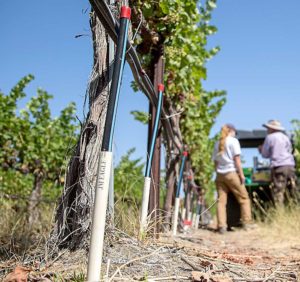—story and photos by Ross Courtney
—photo by TJ Mullinax
Wine grape growers have long used pressure chambers to measure plant water stress. A Northwest researcher thinks tree fruit growers could benefit from doing likewise.
“I would recommend growers to try using it, but it is an ‘old-school’ approach now that growers are looking to use modern sensors,” said Matt Whiting, a tree fruit physiologist at Washington State University.
Pressure chambers, sometimes nicknamed pressure bombs or Scholander bombs, use pressurized gas to measure the water potential and therefore water stress of a plant.
Wine grape growers do this because they want to stress their vines to coax flavor from the berries. It’s called deficit irrigation. Whiting suspects tree fruit growers could use the gauges to determine when their trees are water-stressed, then irrigate to mitigate that stress.
Pressure chambers come in two variations, and both are portable. One is powered by compressed nitrogen — a middle-of-the-road model would fit on an ATV and cost about $3,500. The smaller version works like a handheld bike pump and costs between $1,400 and $2,000.
Both gradually force gas into a chamber containing a sample leaf with only the petiole protruding. An adjacent gauge measures the pressure in the chamber. The pressure required to force a bit of fluid to protrude from the end of that stem is equal and opposite to the water potential of the plant. The higher the pressure, the tighter the leaf’s pull on its water. The term “water potential” refers to this tension measurement of plant water-stress and is expressed in negative units of pressure.

Nut growers in California use water potential gauges to inform irrigation decisions. For example: A certain amount of water stress at certain times can help prompt a tree to release its nuts from their husks, but too much water stress will harm the tree.
About 10 years ago, farm advisors for the University of California Cooperative Extension published a guide for English walnut, almond and prune trees. A reading of negative 16 to negative 20 bars of stem water potential in prune means moderate to high stress with shoot growth slowing or stopping, but also a boost in fruit sugar levels. Any lower than that, however, could diminish the tree’s condition entering dormancy.
Whiting wants to set similar guidelines with apples and cherries, to tell growers the stress level at which fruit quality will suffer. Some of that has been determined. In his experience, a reading of negative 17 bars usually means cherry quality starts to suffer, but he doesn’t know how factors such as length of stress or time of year play a role.

Whiting, a cherry expert, does not know of any growers using pressure chambers in their commercial operations. He and other research staff at WSU’s Irrigated Agriculture Research and Extension Center demonstrated a pressure chamber in May at an irrigation field day for Spanish-speaking industry employees near Prosser. Their curiosity was noticeable as the group crowded around to watch.
Researchers frequently rely on pressure chambers, and many of the heat-stress mitigation tools under review by Whiting’s colleagues are calibrated on their results. WSU staff have been measuring stem water potential in samples from apple trees at the Smart Orchard, a commercial block near Mattawa set aside for research and technology trials.
Jeff Hamel, owner of PMS Instrument Co., suspects some tree fruit growers use pressure chambers, though not as commonly as do nut crop growers. Pear growers in Northern California have used stem water potential guidelines to inform irrigation decisions, and Hamel has heard of researchers using well-timed water stress near harvest to help apples develop color.

He encourages more growers to try the tool. He likens the process to taking a person’s blood pressure. The chambers measure a tree’s water content, while soil moisture sensors and evapotranspiration sensors measure the environment around the tree, he said.
“We can quantify the water stress in the plant,” Hamel said.
Maria Zamora Re, assistant professor of biological and ecological engineering and an irrigation specialist at Oregon State University, also recommends growers consider using pressure chambers, even though they are labor intensive. Somebody must drive around and physically take plant samples.
Specialty crop industries are eyeing new tools that attempt to automate measuring water stress in plants, but researchers are still experimenting with them — and comparing them to the pressure chamber.
“It’s almost like the gold standard for determining the water status in the plant,” she said. •
More about pressure chambers:
Oregon State University produced a two-part instructional video for scheduling irrigation with a pressure chamber.
Watch Part 1 online at: bit.ly/pressure-chamber-part-1.
Watch Part 2 online at: bit.ly/pressure-chamber-part-2.








Leave A Comment